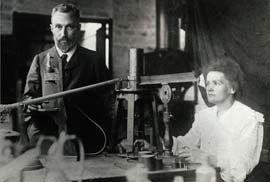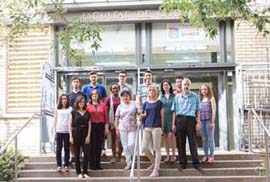
Marie Curie, one of the most brilliant scientists in history, died in 4 July 1934, leaving behind several merits and findings which led her to get two Nobel prizes, in Physics and Chemistry, and to lose her life due to her big discovery: radioactivity.
4 july 2016
In 2011 the International Year of Chemistry took place. Why this year? To commemorate the 100th anniversary of the Nobel in Chemistry bestowal to Marie Curie. A fact which shows how important Marie Curie was for science in general and for chemistry in particular.
This Polish scientist, whose maiden name was Maria Sklodowska, lived and died for science. Since she was young, she had to fight innumerable obstacles: from being poor to the difficulties of an obsolete system which did not let women attend University at the beginning of the 20th Century. But Marie Curie kept on going, with such determination, that she reached her goals: she was the first woman to become full university professor at the University of Paris and the first one to get a Nobel Prize for her research on radioactive elements.
Her research life was closely related to that of her husband, Pierre Curie, who she married in 1895. They both threw themselves into their scientific tasks at the same time they took care of their daughters Iréne and Eve. Marie showed interest in new types of radiations after discovering the existence of unknown radioactive elements, term she coined.
In 1898, the couple made the announcement on the discovery of two new elements: polonium and radium. But they still had to work for almost five years in precarious conditions until they could demonstrate the validity of their discoveries. Finally, this discovery was awarded in 1903 with the Nobel Prize in Physics.
The Nobel came along with fame and recognition. Pierre was appointed full university professor at the University of Paris, post Marie will get after her husband death in 1906 as a consequence of a horse chariot wreck. A tragic fact which did not stop this Polish scientist to keep on researching while she taught at the French university. Her works on radium and its compounds led her to get the another Nobel Prize, but this time in Chemistry. It was 1911, and a women scientist had made history, so much that almost 100 years after her death, her legacy is still very present. Tadeusz Estricher, historian, qualified her works as fundamental for the world’s development during the 20th and 21st Centuries.
“The result of Curie’s work was an age of transformations. Radium’s radioactivity was so high that it could not be ignored: it conducted a rethinking of physics basic fundaments, helped on the checkout of atom’s structure and contributed to a successful fight against cancer”, stated Estreicher in 1938.
Paradoxically, radiation ended up killing Marie Curie. Its harmful effects, which she was exposed to in her work, were probably the main cause of the aplastic anaemia she got and which ended her life on 4 July 1934. 82 years have gone by, but she still is and will be present in the scientific community.















